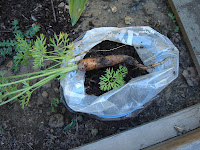I've been backyard composting for over a year. I was so tired of piling up my neighbor's leaves and our mowed grass in the street for the City to pick up. It felt like such a waste.
SELECTING A COMPOSTER
There are many different types of composters available. This site gives detailed info and specs on compost bins for less than $100, but it isn't necessary to purchase a bin; my auntie digs a big hole and buries organic material.
I purchased an Earth Machine (EM) through a program offered by Santa Clara County Recycling and Waste Reduction Commission. The County offers a free composting class and the EM for $55. I did a lot of compost bin research and found the EM to be the best for the price. It is round, making it easier to turn the compost and the screw-on-top keeps out unwanted critters.
GETTING STARTED
I dug up a sunny dirt area in my backyard and placed the EM directly on top of the newly turned soil. I added the big pile of leaves and freshly cut grass; basically, adding equal parts of "browns", which are high in carbon, and "greens" which are high in nitrogen.
Brown: dry leaves*, cardboard (paper towel, toilet paper, wrapping paper tubes)
Green: grass, kitchen scraps (fruits, veggies, coffee grounds, tea bags, cut leaves)
NOTE: Do NOT add animal waste, meat, or dairy
I mixed them together, then added water. The mixture should be damp like a sponge, not sopping wet. After a few days of "cooking" the pile decreased in size.
I kept adding materials (trying to maintain the 50% brown, 50% green mixture), watering and turning the heap until the bin was 75% full. A couple of weeks later, I wasn't completely satisfied with the progress, so I mixed in roughly two gallons of compost that I'd gotten from the City to help the process.
COMPOST COMPLETE!
Four months later it was ready!** It looks like damp soil when done. I didn't water it for a couple of weeks (but continued to turn) to let it dry out a little then sifted out all the things that didn't break down completely (and put those things back into the bin for the next batch).
In the second batch, I added a lot more kitchen scraps and ended up with a bin full of earthworms. They must have come up from the soil under the bin.
* The instructor in the class I attended said that anything that falls off a tree naturally (vs. cut) is considered brown
** Breakdown slows during colder months. Keep adding material and turning; it will begin cooking when the weather gets warmer.
 a fabric wrap (I made it out of scrap fabric and a snap),
a fabric wrap (I made it out of scrap fabric and a snap), a knitting accessory (I think they keep knitting needles together),
a knitting accessory (I think they keep knitting needles together),



















